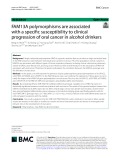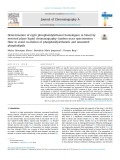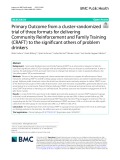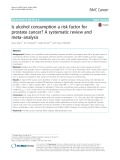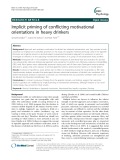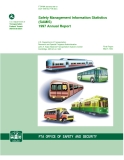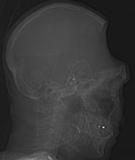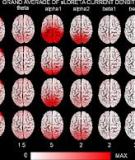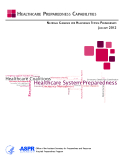
Alcohol drinkers
-
Single nucleotide polymorphism (SNP) is a genetic variation that occurs when a single nucleotide base in the DNA sequence varies between individuals and is present in at least 1% of the population. Genetic variants in FAM13A are associated with different types of chronic respiratory diseases, including chronic obstructive pulmonary disease (COPD), cystic fibrosis (CF), and lung cancer.
 9p
9p  vioracle
vioracle
 29-09-2023
29-09-2023
 8
8
 4
4
 Download
Download
-
Phosphatidylethanols (PEths) are specific, direct alcohol biomarkers with a substantially longer half-life than ethanol, and can be used to distinguish between heavy- and social drinking. More than forty PEth homologues have been detected in blood from heavy drinkers, and PEth 16:0/18:1 is the predominant one.
 9p
9p  vironald
vironald
 15-12-2022
15-12-2022
 7
7
 2
2
 Download
Download
-
Community Reinforcement and Family Training (CRAFT) is an intervention designed to help the concerned significant others (CSOs) of people with alcohol problems who are reluctant to seek treatment. It aims to improve the well-being of CSOs and teach them how to change their behavior in order to positively influence the “identified patient” (IP) to seek treatment.
 16p
16p  viferrari
viferrari
 28-11-2022
28-11-2022
 8
8
 2
2
 Download
Download
-
This study examined the prevalence of screening and brief intervention (SBI) for alcohol use disorder (AUD) risk in samples of adult drinkers in three middle-income countries (Brazil, China, South Africa), and the extent to which meeting criteria for AUD risk was associated with SBI.
 9p
9p  viferrari
viferrari
 29-10-2022
29-10-2022
 4
4
 3
3
 Download
Download
-
Research on a possible causal association between alcohol consumption and risk of prostate cancer is inconclusive. Recent studies on associations between alcohol consumption and other health outcomes suggest these are influenced by drinker misclassification errors and other study quality characteristics.
 13p
13p  vimale2711
vimale2711
 25-08-2020
25-08-2020
 11
11
 1
1
 Download
Download
-
Approach and avoidance motivation for alcohol are relatively independent, and they operate in both automatic (or implicit) and controlled processes. In this study, we adapted methods previously used in the appetite literature and implicitly primed an alcohol-related motivational orientation (approach or avoidance) in order to investigate its influence on the opposing motivational orientation, in a group of non-dependent heavy drinkers.
 13p
13p  viriyadh2711
viriyadh2711
 19-12-2019
19-12-2019
 12
12
 0
0
 Download
Download
-
Advice from the Health Education Board for Scotland (now NHS Health Scotland) is that light, occasional drinking during pregnancy (one or two units once or twice a week) is not likely to do any harm.78 Heavy drinking is associated with miscarriage, and sometimes with serious effects on the babys development.78 Some authorities recommend complete abstinence during pregnancy (the US National Institute on Alcohol Abuse and Alcoholism: http://www.niaaa.nih.gov/publications/brochure.htm). Two studies have been identified which looked at brief interventions in the antenatal setting.
 165p
165p  seketnoi
seketnoi
 26-04-2013
26-04-2013
 44
44
 2
2
 Download
Download
-
There is consistent evidence from a large number of studies that brief intervention in primary care can reduce total alcohol consumption and episodes of binge drinking in hazardous drinkers, for periods lasting up to a year. There is limited evidence that this effect may be sustained for longer periods. All groups under study reduced alcohol consumption, but those with brief interventions did so to a greater extent than those in control groups.
 0p
0p  seketnoi
seketnoi
 26-04-2013
26-04-2013
 44
44
 3
3
 Download
Download
-
The overall fragility of the marginal wine drinker segment is highlighted by the long-term trend among them for growing preferences of other forms of beverage alcohol over wine. In the 2003 Merrill Research study, only 50 percent of marginal wine drinkers stated that they actually preferred wine over beer and spirits. Marginal wine drinkers have trimmed their wine consumption levels overall in the past three years.
 0p
0p  khanhchilam
khanhchilam
 01-04-2013
01-04-2013
 42
42
 5
5
 Download
Download
-
The greatest shift in consumer purchase behavior over the past generation has been from table wines to quality wines, particularly in traditional wine drinking countries. Relatively few people consume wine. In the United States 40 to 45 percent of the adult population does not drink any alcoholic beverages. Of the remainder, less than 20 percent are “regular” wine drinkers, and they account for most of the wine consumption. The occasional wine drinker, an additional 40 percent of the remainder, tends to like wine and might buy more of it if persuaded to do so (Moulton...
 0p
0p  khanhchilam
khanhchilam
 01-04-2013
01-04-2013
 53
53
 5
5
 Download
Download
-
Early-Onset drinkers or ‘Survivors’ are those people who have a continuing problem with alcohol which developed in earlier life. It is thought that two thirds of elderly problem drinkers have had an early onset of alcohol misuse. However, because of the health risks connected to heavy drinking and dependence on alcohol, the chances of reaching old age are reduced - one estimate is that the life span of a problem drinker may be shortened by on average ten to fifteen years.
 6p
6p  thankinhphanliet
thankinhphanliet
 01-01-2013
01-01-2013
 58
58
 8
8
 Download
Download
-
Generally, alcohol consumption declines with age and the proportion of non-drinkers increases. The reasons for this decline in consumption are presumably connected to changes in life circumstances and attitudes and, in the later middle aged and older, growing ill health. There is evidence that today’s population of elderly people may be relatively heavier drinkers than previous generations.
 6p
6p  thankinhphanliet
thankinhphanliet
 01-01-2013
01-01-2013
 53
53
 3
3
 Download
Download
-
A recent government health survey found that 1 to 5 per cent of elderly people who drank more than occasionally were ‘problem drinkers’, reporting significant psychological and/or physical dependence on alcohol. Other studies have found higher proportions of elderly problem drinkers, especially in men. One found 5 - 12 per cent of men in their 60’s to have alcohol problems.
 4p
4p  thankinhphanliet
thankinhphanliet
 01-01-2013
01-01-2013
 60
60
 5
5
 Download
Download
-
Contrary to the belief of many people, the health, safety and socioeconomic problems attributable to alcohol can be effectively reduced. Many evidence-based alcohol policies and prevention programmes are shown to work. One of the most effective is raising alcohol prices by raising taxes. This has the added benefi t of generating increased revenues. A recent analysis of 112 studies on the effects of alcohol tax increases affi rmed that when taxes go up, drinking goes down, including among problem drinkers and youth.
 73p
73p  quygia123
quygia123
 01-11-2012
01-11-2012
 35
35
 0
0
 Download
Download
-
Harmful alcohol consumption is risky both for the drinker and for other people. An intoxicated person can put people in harm’s way by involving them in traffi c accidents or violent behaviour, or by negatively affecting co-workers, relatives, friends or strangers. A survey in Australia found that two thirds of respondents were adversely affected by someone else’s drinking in the past year. Alcohol consumption also affects society at large.
 26p
26p  quygia123
quygia123
 01-11-2012
01-11-2012
 44
44
 4
4
 Download
Download
-
The hazardous and harmful use of alcohol is a major global contributing factor to death, disease and injury: to the drinker through health impacts, such as alcohol dependence, liver cirrhosis, cancers and injuries; and to others through the dangerous actions of intoxicated people, such as drink– driving and violence or through the impact of drinking on fetus and child development. The harmful use of alcohol results in approximately 2.5 million deaths each year, with a net loss of life of 2.
 32p
32p  quygia123
quygia123
 01-11-2012
01-11-2012
 47
47
 0
0
 Download
Download
CHỦ ĐỀ BẠN MUỐN TÌM








